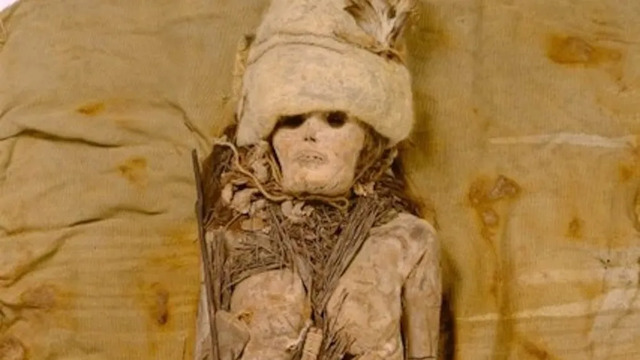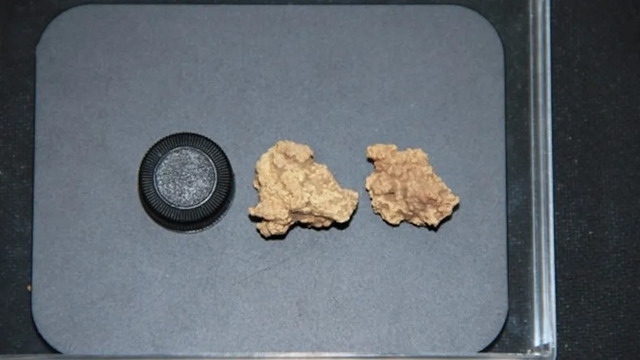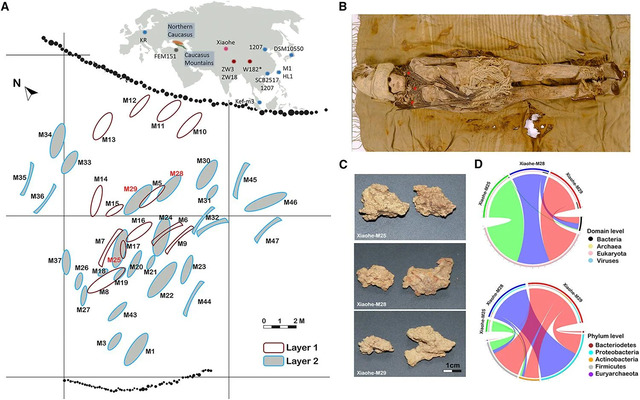Buried for 3,600 years in the desert sands of China’s Tarim Basin, an ancient mystery has been unraveled. The discovery of kefir cheese smeared on mummies has revealed not only the world’s oldest cheese but also unlocked a window into the diet and culture of a long-lost civilization. This groundbreaking find challenges our understanding of ancient food practices and offers insights into the sophisticated use of probiotics thousands of years ago.
Introduction: The Discovery of the World’s Oldest Cheese
In 2014, archaeologists unearthed several mummies from the Xiaohe Cemetery in the Tarim Basin, an area in Northwestern China. Amidst the usual archaeological finds, one discovery stood out: a mysterious white substance smeared on the heads and necks of these mummies. At first, the exact nature of this substance was unclear. But with recent advancements in DNA analysis, scientists have confirmed it to be the world’s oldest known cheese — kefir, a probiotic dairy product. This finding, dated to around 3,600 years ago, has opened a new window into the diets, cultures, and practices of ancient civilizations. The significance of this discovery is immense, not just in terms of food history, but also in understanding ancient burial rituals and the evolution of probiotic bacteria.
Video
Watch the video to discover China’s oldest cheese, found in an unexpected location. This surprising archaeological find is a game-changer in food history!
The Discovery of Cheese on Ancient Mummies
The cheese was first found nearly two decades ago, scattered on several mummies at the Xiaohe Cemetery in the Tarim Basin. Researchers were initially perplexed by the strange, white substance on the bodies, and it took years of scientific work to identify it. At the time, the material was not recognized as cheese, but recent advancements in DNA extraction technology, led by Qiaomei Fu from the Institute of Vertebrate Paleontology and Paleoanthropology at the Chinese Academy of Sciences, have unveiled its true nature. The substance was not only dairy-based but also contained a specific bacterial profile that pointed to kefir — a probiotic, fermented product made from cow and goat milk.
This revelation places kefir cheese at the forefront of ancient food research. It challenges previous assumptions about the geographical origins of kefir and opens up new avenues for understanding the ancient world.


Kefir Cheese: A Probiotic and Ancient Delight
Kefir, the type of cheese identified on the mummies, is a fermented dairy product that has been consumed for thousands of years. Traditionally, kefir is made from cow, goat, or sheep milk fermented by a combination of bacteria and yeast. The bacteria responsible for fermenting the milk into kefir are symbiotic, existing in a delicate balance. The presence of kefir in such ancient remains adds a new chapter to the story of this unique product, suggesting that the practice of fermenting milk into kefir may have originated far earlier than previously believed.

Kefir’s appeal lies not only in its taste but in its health benefits. It is rich in probiotics, which are known to support digestion and immune function. The discovery of ancient kefir allows modern researchers to compare its historical versions with today’s strains, giving insight into the evolution of probiotic cultures.
DNA Analysis: Uncovering the Ingredients of Ancient Cheese
The key to identifying this ancient cheese was the extraction of mitochondrial DNA from the samples found on the mummies. This method allowed researchers to confirm that the cheese was made from cow and goat milk. The DNA also revealed the presence of two bacteria that are crucial in the fermentation process: Lactobacillus kefiranofaciens and Pichia kudriavzevii. These two bacteria are present in modern kefir grains and are responsible for the characteristic tang and texture of the cheese.
Interestingly, genetic analysis also revealed that the Lactobacillus kefiranofaciens strain found in this ancient cheese was closely related to strains found in Tibet today. This challenges the long-held belief that kefir originated solely in the Caucasus Mountains of Russia, suggesting that kefir culture may have been maintained in northwestern China since the Bronze Age.

The Cultural and Dietary Implications of the Discovery
The discovery of kefir cheese on these ancient mummies opens a window into the diet and culture of the Xiaohe people, who lived in the Tarim Basin. It is a testament to their advanced food production techniques and their sophisticated use of fermentation to preserve food. Furthermore, kefir’s presence in the burial site raises intriguing questions about the role of food in death rituals.
One possible explanation for smearing the cheese on the mummies is that it had a ritualistic or symbolic purpose. The Xiaohe people might have believed that this rare and nutritious food could sustain the spirits of the dead in the afterlife. Such practices suggest that food was not just for nourishment but also played a central role in their spiritual beliefs.
The Evolution of Kefir Bacteria: A 3,600-Year Journey
The study of the kefir bacteria found in this ancient cheese is a groundbreaking aspect of the research. Genetic analysis showed that Lactobacillus kefiranofaciens in the ancient samples was more potent than its modern counterparts, indicating that it could have been more likely to trigger immune responses in the human digestive system at the time. Over the past 3,600 years, this strain of bacteria seems to have evolved, becoming more stable and less likely to cause immune reactions.
This aspect of the discovery allows researchers to observe how bacteria have evolved alongside humans, adapting to environmental and dietary changes over millennia. It provides a fascinating look at how the symbiotic relationship between humans and probiotics has developed over time.
The Mystery Behind the Use of Cheese in Mummification
While the scientific findings about the cheese are impressive, the question remains: why was cheese used in the mummification process? One theory suggests that the Xiaohe people may have smeared the cheese on the mummies as part of a belief that it would sustain the deceased’s spirit in the afterlife. Alternatively, it could have been used as an offering, a rare delicacy intended to ensure a favorable afterlife.
The exact reasons for this practice remain unclear, but the presence of kefir cheese in ancient burial sites adds a new layer to our understanding of ancient rituals. The connection between food and death rituals, particularly in ancient cultures, is an area ripe for further exploration.
Conclusion: Reflecting on the Past Through Dairy
The discovery of 3,600-year-old kefir cheese on the mummies from the Tarim Basin is a stunning archaeological find that provides more than just insight into ancient food practices. It offers a unique glimpse into the culture, diet, and belief systems of the Xiaohe people. By examining ancient dairy products like kefir, we gain a clearer understanding of how our ancestors interacted with the world around them, including their use of probiotics, their dietary habits, and their spiritual practices.
This rare discovery also highlights the importance of DNA analysis in archaeology. What was once a mysterious substance has now become a key to unlocking secrets about human history. The study of ancient foods, particularly probiotic products like kefir, is providing a new lens through which we can understand the evolution of human culture and the complex relationships between food, health, and spirituality. As further research unfolds, the story of this ancient cheese will continue to surprise and enrich our understanding of the distant past.
Video
Check out the video to see how the Mummy Princess looked when she was alive. The restoration reveals an incredible glimpse into her past!



